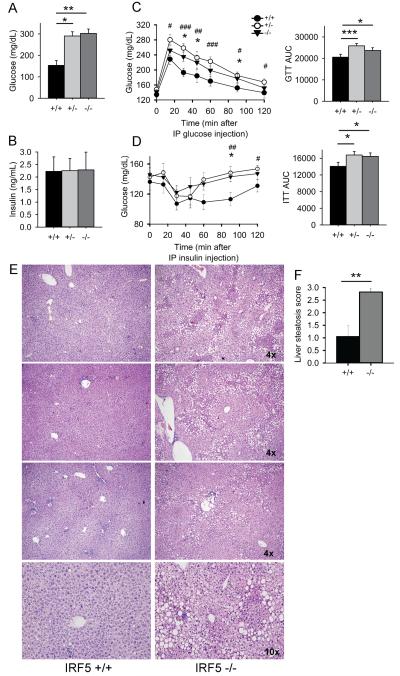FIGURE 4.
IRF5 deficiency leads to insulin-resistance and liver steatosis in gld.apoE−/− mice. (A and B) Male and female gld.apoE−/− mice were euthanized at 19 weeks of age after 12 weeks on western diet and samples collected for analysis. (A) Glucose levels and (B) insulin levels in sera of Irf5+/+ (n=5), Irf5+/− (n=4) and Irf5−/− (n=7) gld.apoE−/− mice. (C) Glucose tolerance tests (GTT) and (D) Insulin tolerance tests (ITT) were performed on male Irf5+/+ (n=14-15), Irf5+/−(n=16-17) and Irf5−/− (n=12-13) gld.apoE−/− littermate mice on western diet for 6-8 weeks. Time-course data is shown in the left hand panels and total area under the curve (AUC) is shown in the right hand panels. Error bars represent the mean and SEM. (E) H & E stained liver sections from three separate pairs of Irf5+/+gld.apoE−/− and Irf5−/− gld.apoE−/− littermate mice on western diet for 12 weeks. Top 6 panels: 4x magnification; Bottom 2 panels: 10x magnification of top 2 panels. (F) Severity of liver steatosis was scored in liver sections from Irf5+/+ (n=5) and Irf5−/−(n=7) gld.apoE−/− littermate mice. (A,C,D) 2-way ANOVA. # denotes comparison Irf5+/+ and Irf5+/− gld.apoE−/− littermate mice whereas * denotes comparison between Irf5+/+ and Irf5−/− gld.apoE−/− littermate mice. (F) Student’s t test (two-sided). *,# p < 0.05, **,## p < 0.01, ***,### p < 0.001.

